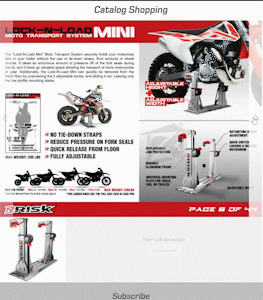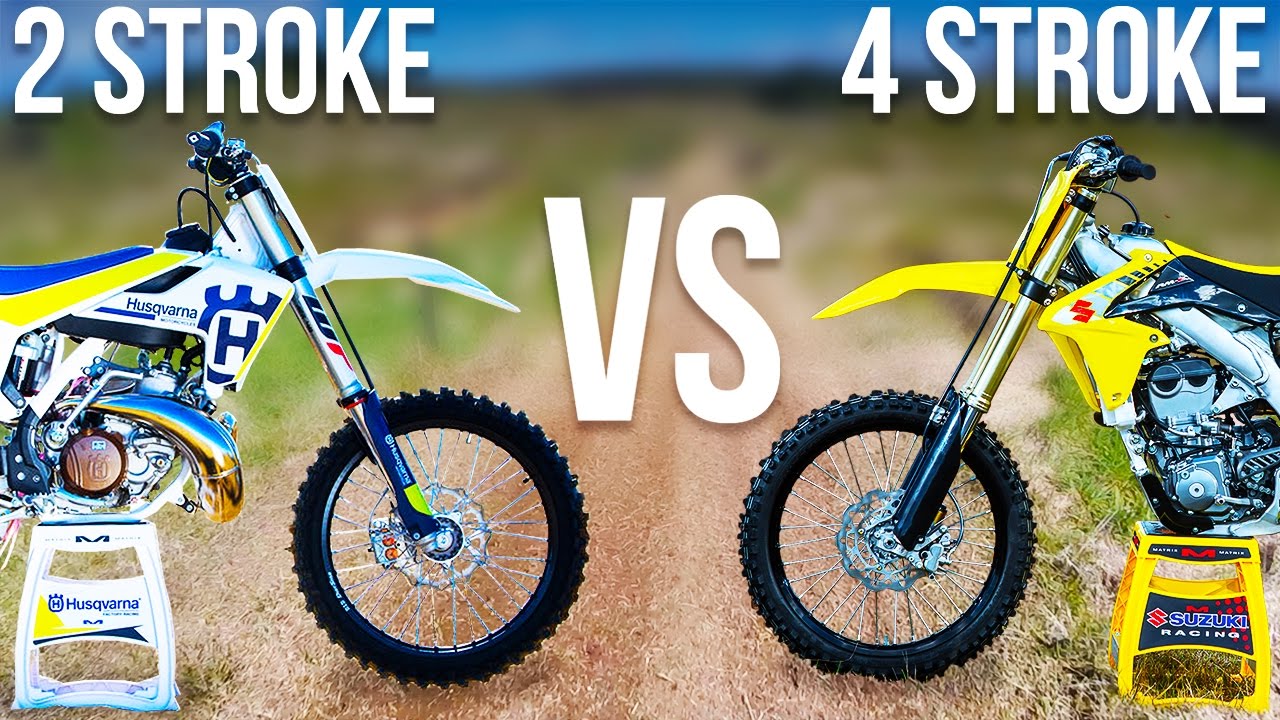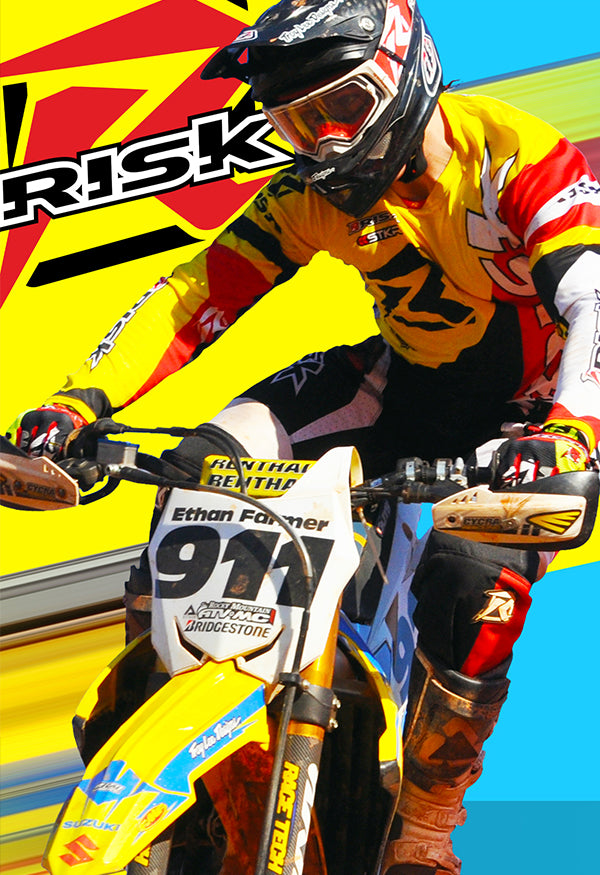Your Cart is Empty
MOTO Products
shop your way
Choose a shopping experience
Same great Risk Racing products, 3 completly different ways to shop them.
Choose a shopping experience
Same great Risk Racing products, 3 completly different ways to shop them.

Lifestyle Shopping

eComm Shopping

Catalog Shopping
MOTO TYRES
MOTO Gear & Apparel
What’s Better, 2-Stroke or 4-Stroke Dirt Bikes? - The Differences
January 27, 2022 9 min read

Here’s a question that might get you into a few arguments. You might find that you’ll have to agree to disagree on this one because it’s hard to change the mind of anyone that has a preference. You might as well be asking someone what’s better out of chocolate or vanilla ice cream. Both are great and both have their advantages.
There are numerous differences between 2-stroke and 4-stroke dirt bikes that give them their advantages and disadvantages. Because of their differences in the way they are made, you cannot successfully determine which is better than the other.
The only way you can say which is better is by pure opinion-based biased claims. This rivalry, however, will go down in history as never having a genuine winner. The best you can do is learn all there is to know about both kinds so that you can make an educated decision on which you’d prefer. Read on below for all you need to know about 2-stroke and 4-stroke dirt bikes.

What Does 2-Stroke Mean?
Due to the ease and slightly more simple mechanisms of the 2-stroke dirt bikes, they were designed and implemented before the 4-stroke bikes.
2-stroke bikes only require the bike’s engine to use one power cycle to the cylinder with 2 strokes of the piston.
Meaning they power up and take off much quicker than a 4-stroke, with the combustion and compression happening simultaneously with the intake and exhaust functions of the engine happening at the same time.
Unfortunately, 2-strokes are a dying breed. The Environmental Protection Agency (EPA) has tightened restrictions on vehicle exhaust emissions and 2-strokes weren’t living up to new standards.
Fortunately, Yamaha, KTM, and Husqvarna, among a few others, have figured out a way to manufacture 2-stroke bikes, adhering to EPA regulations and are still making these little legends for those that prefer a lighter, 2-stroke engine dirt bike.
Here is a list of the main differences you will find in a 2-stroke engine:
The engine is smaller
Having a smaller engine makes these bikes easier to work on. If maintenance is required, instead of having to pull out the whole engine, you might be able to use the extra space provided through the small engine to perform your bike’s maintenance.
Maintenance is easier
Again, because of the smallness of the engine, it’s much easier to get in, and around the engine of the bike to carry out maintenance on your bike. There are also fewer electrics involved in the design of a 2-stroke bike so there’s less to maintain overall.
Less moving parts on the 2-stroke
The engine is a much simpler design than a 4-stroke. 2-stroke engines are smaller and simpler because there are fewer moving parts on the bike. There’s no timing chain, valves, and camshafts, so the ease of maintaining a 2-stroke is beneficial.
2-stroke bikes are lighter
Yes, you guessed it. With a smaller engine size, a simpler design, and less parts overall, a 2-stroke bike is lighter than a 4-stroke. You might find this beneficial on the racetrack for maneuverability, picking up the bike if you fall, loading and unloading, and you might not have to use as much energy on the track if you’re a decent rider.
Heavier bikes can take more energy and effort to ride than lighter bikes, so this is a huge advantage for the 2-stroke bikes.
Cost-effective on maintenance
Because of the smaller and simpler engine design with less moving and electrical parts, 2-strokes can be cheaper in maintenance because you might be able to make your own mechanic decisions and adjustments as needed. There are also fewer parts to get worn out and need replacing. Hence, 2-stroke bikes might save you money in mechanical issues.
What Does 4-Stroke Mean?
In comes 4-stroke engines, with the ability to better control exhaust emissions. Using 4 strokes of the pistons and two full rotations through the cylinder with 4 stages.
The 4 stages are:
- Intake (Suction)
- Compression (Preparation)
- Combustion (Ignition/power)
- Exhaust (Outlet)
Of course, due to the friendlier environmental sustainability and linear power band of the 4-strokes, they are taking over the 2-strokes. Much to the disappointment of some, and to the happiness of others that get to say, “I told you 4-strokes were better”.
But just because two-strokes (not all) have slowly fazed out over recent years, it still doesn’t prove that 4-strokes are superior.
Here are the main differences you will find in a 4-stroke dirt bike:

Stability on the track.
4-stroke bikes don’t dance around on the track as much as a 2-stroke. Because 2-strokes are lighter, they have been known to “dance” on the track and can be less stable on the track. Some riders might enjoy this flight feeling, but if you’re not used to it, you’d probably prefer a 4-stroke.
With the heavier 4-stroke bikes, the big advantage here is the stability on the track. This might be preferred when riding on open, high-speed terrain.
Don’t need to be as agile.
The heaviness of a 4-stroke bike keeps them more planted or “grounded” on the track. This also means you don’t have to move your body so much with the bike. Unlike the 4-stroke bikes, riders on a 2-stroke need to be very agile to keep up with the bike’s light maneuverability on the track.
Predictable, consistent power.
4-stroke bikes produce consistent and smooth power. Which also means less use of the clutch. This can be highly beneficial on high and steep track climbs where the 4-stroke produces steady power up the climb with little effort from the rider.
2-strokes, though fast and powerful, are less consistent and fluctuate in their power.
No pre-mixed fuel.
Unlike 2-strokes, the 4-stroke bikes don’t require pre-mixed fuel. Pre-mixed fuel is the combination of gasoline and oil and is more expensive than normal fuel. Another advantage for the 4-strokes.
Better traction.
The consistent and smooth power that 4-stroke bikes offer means they also create better traction than 2-strokes. Depending on your riding ability, you should be able to provide constant and stable power to your bike which in turn will give you better traction no matter what gear you’re in.
Less use of clutch and throttle.
Depending on how much you enjoy using your clutch and your throttle, 4-strokes might be a better option for you if you’re on the lesser side of favoring the clutch and throttle.
4-stroke offers a wider power reach throughout the track because of their consistent power range. This means less use of the clutch and the throttle. Whereas 2-strokes, although powerful to begin with, have fluctuating power and less consistency. This means you would need more use of the throttle and clutch to keep up with the reliable overall power of the 4-stroke.
What’s Easier to Ride out of 2-Stroke and 4-Stroke?
It’s generally easier to ride a 4-stroke dirt bike on wide, open, and fast tracks. 2-stroke bikes are better suited to a more technical landscape. This does not make one better than the other as both are designed and manufactured to ride all types of terrain.

The ease of riding a 2-stroke or 4-stroke bike will also depend on your physical abilities.
2-strokes are commonly made lighter so are slightly easier to pick up if fallen, as well as load and unload into the transport trailer. As well as being lighter for off-the-track movement, they are lighter on the track and have less traction, so you need to be in pretty good shape to keep control of a 2-stroke bike if you’re riding on harsh and bumpy tracks.
4-stroke bikes have good traction but are still made heavier with a larger engine, so your fitness and physical levels need to be just as good to manage the weight of this heavier bike.
If you’re riding out in the open, on wider tracks with less sharp corners and bumps in the ground, and with steeper hill climbs, you might consider a 4-stroke easier to ride. Whereas bumpy tracks with sharp corners, and quick dips, might be better suited to 2-stroke bikes.
Either way, both are intended to go fast and to be ridden by someone with the strength to manage their weight, maneuverability, traction, and power.
What’s Faster out of a 2-stroke and a 4-stroke Dirt Bike?
Another question that might get you into an argument with the ‘other’ guys is which bikes are faster. Again, it’s not a straight answer.
2-strokes and 4-strokes are manufactured differently. Yes, they’re both designed to be fast engine-powered bikes, ridden on harsh outdoor tracks, up steep hills, around tight bends, over bumpy and uneven surfaces, through mud, and over difficult terrain. But the simple fact is that they were designed differently.
As you’ve read, the 2-stroke bikes have smaller engines, are lighter, have less traction, but more initial power. 4-stroke bikes are heavier, have more stability and traction on the track, but have the higher horsepower for overall power.
This means that both are fast. But 2-strokes take more energy to ride in the sense of clutch and throttle use, whereas 4-stroke bikes take more strength to ride because of the heaviness of the vehicle.
With the 4-stroke’s consistent power, less need for the use of rider’s agility, and better traction on the track, comes the advantage of staying faster for longer. Without the need to consciously use the clutch and the throttle also comes higher concentration on the finish line straight ahead.
- 150cc 2-stroke dirt bike would match the power of a 250cc 4-stroke dirt bike.
- 250cc 2-stroke dirt bike would be a little less powerful than a 450cc 4-stroke dirt bike.
Why are 2-Stroke Engines Banned?
Actually, 2-stroke dirt bikes are not banned. Some companies are still manufacturing 2-stroke bikes and are leaders in their field of innovation and more complex 2-stroke engines that are on par with 4-stroke sustainability. Yamaha is one of these companies, using reed valves to avoid emitting further fumes into the environment.
Although 2-strokes aren’t banned, and some brands are still manufacturing them, there are more 4-stroke bikes on the market today.
We’re huge fans of the environment at Risk Racing and we are all about keeping the planet clean and making it a safe place for our present and our future. Especially if that means we can keep riding our beloved bikes.
When the Environmental Protection Agency (EPA) brought in new and stricter laws to reduce pollution from vehicles and engines, 2-strokes came under fire.
With the mechanical ability to only use one power cycle and two strokes of the piston, the 2-stroke dirt bikes have higher vehicle exhaust emissions. The burnt oil in the engine gets released into the air through the exhaust and is released into the air which is bad for the environment.
You can read the EPA’s advice here on how to minimize your pollution from vehicles and engines.
Here’s why 2-strokes aren’t great for the environment unless the manufacturer has made some alterations to make them more environmentally sustainable:
- Higher fuel consumption.
- Burnt oil fumes.
- Releases emissions into the air.
- Causes greenhouse gasses which cause climate change.

What exactly do emissions do to our environment?
It’s not just our environment that we should be wary of with emissions. These pollutants in the air, caused by emissions, can exacerbate respiratory diseases, and also cause harmful pollutants to enter your lungs.
The EPA and other environmental agencies are doing what they can to reduce these emissions to create a safer world for humankind.
The pollution caused by, but not limited to, exhaust fumes, emits greenhouse gasses that cause climate change. But that’s a whole other issue we’re not going to delve into right now. For now, just know that 2-strokes aren’t banned, so you can calm down.
It doesn’t mean we, as avid and enthusiastic dirt bike riders, have to stop riding. It just means we need to be more aware of the situation and help where we can. So, the dirt bike industry started to faze out 2-strokes and marginally manufacture 4-strokes more.
Modern-day 2-strokes live up to the EPA’s standards and are currently still on the market. Check out Yamaha’s latest 2-stroke beauty here if you don’t believe me.

Comparisons
We’ve put together a little comparison table so you can quickly see what the main differences between 2-stroke and 4-stroke dirt bikes are.
Check it out here:
| 2-Stroke | 4-Stroke | |
| Engine Size | Smaller engine | Larger engine |
| Engine Power | More power per cubic centimeter (cm3) 125 2-stroke VS 250 4-stroke | Less power per cubic centimeter (CM3) 250 2-stroke VS 450 4-stroke |
| Horsepower | Produces less horsepower, approx. 46hp for a standard 125cc 2-stroke. | Produces more horsepower, approx. 56 hp for a standard 250cc 4-stroke |
| Starting | Less energy to start, quicker start. | More strength to kick, slower start. |
| Maintenance | Easier and quicker maintenance with a smaller engine. Might also be cheaper. | Might have to remove the tank or engine to complete maintenance. This could get costly. |
| Sound | Higher sound, like a high-powered drone. | Louder and deeper. |
| Costs | 2-strokes are typically cheaper because they have less parts | More expensive because more parts in the engine. |
| Weight | Lighter approx. 227lbs (102kg) average for adult 250cc 2-stroke. | Heavier approx. 240lbs (108kg) average for adult 250cc 4-stroke. |
| Terrain | Advantage on technical terrain. | Advantage on open-high speed terrain. |
| Parts | Fewer moving parts – also contributes to less maintenance and costs. | More moving parts and parts in general which contribute to the heaviness and environmental friendliness. |
| Vibration | High-frequency vibrations are felt throughout the whole bike. This can cause fatigue. | Less vibrations, retaining energy in the motor. |

Conclusion
There you have it, the differences, disadvantages, and advantages of both the 2-stroke and 4-stroke dirt bikes. I can’t tell you which is better because they’re both different and have their own style. Which one you choose to be loyal to is entirely up to you but maybe trying them both out before you choose is a good way to start.
You may not be able to change the mind of someone riding something different to you, but at least you’ll know everything there is to know about both kinds. Happy riding and stay safe on the tracks.
Leave a comment
Comments will be approved before showing up.
Subscribe
Sign up to get the latest on sales, new releases and more …

Limited Time 10% Off
Save on your 1st order and get email offers when you join.
Eligible for first-time website purchases only. Emails may take a few minutes to process and could get flagged by email providers as junk so be sure to wait a little bit and check your junk and/or spam folders.

 UK/EU▾
UK/EU▾






























